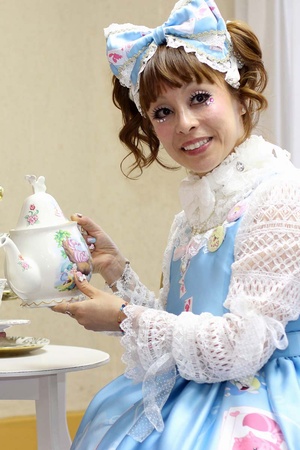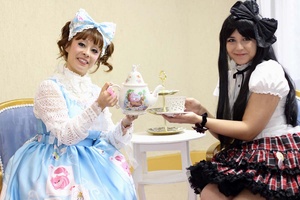Akemi Matsuda, second-generation Nikkei, had lived in Japan from 3 to 19 years old. There, she completed elementary school and, later, opted for what in Brazil is called technical education to study classical ballet.
“I attended a school like the Bolshoi in Russia,” she says. “In the morning, we studied regular school subjects normally. After lunch, it was just the practice of classical ballet. We studied the history of ballet, music, how to build a stage... It was all directed towards the formation of dancers.”
In Japan, Akemi was able to work as a ballet dancer. With her training in classical ballet, she would have a paid job in a dance company. “I really wanted to be a professional classical dancer,” she explains.
The Lolita fashion
However, Akemi decided it was time to return to Brazil. “I decided to take a risk in returning to Brazil and had a great growth in learning and passion for dancing,” she says.
However, professions related to the arts in Brazil hardly have recognition in financial terms. In many cases, it is not feasible to obtain a living exclusively from it. “I stopped dancing five years ago. Today, it had improved, but five to ten years ago, it was very difficult to dance and pay the bills. We ended up paying to dance,” says Akemi.
“I was in a long-lost phase. I did not know if I should continue dancing, I did not know what I wanted of life,” she recalls. At that time, she worked in a store specialized in selling manga and articles related to Japanese pop culture and as a Japanese teacher in order to finance her career as a dancer.
In 2006, because of her work at the shop, Akemi attended an event in Porto Alegre [Southern State of Brazil] called Animesul. It was then that she discovered lolita fashion. “I saw a gothic lolita. She was in black and white, beautiful and gorgeous. It was spectacular,” she says.
Despite the all the time she lived in Japan, Akemi didn’t discover that style until she came back to Brazil. “All that passion of so many years for ballet was transported to the lolita fashion. For me, the lolita fashion has a lot to do with classical ballet,” says Akemi.
“As soon as I returned to Sao Paulo, I did not think twice. I went to the 25 de Março [one of the most famous trade districts of town] to buy cloth. I prepared two looks in two weeks.” Thus, thanks to the years at ballet school, Akemi could produce her own lolita clothes.
For her, the resemblance goes further. “The two universes are united because in classical ballet, it is a fairy tale all the time; it is the same in lolita fashion. First, the matter of aesthetics. Most dresses are inspired by fairy tales. Sleeping Beauty, Alice in Wonderland, Pinocchio... These stories and tales we hear as a child. In classical ballet, there are Swan Lake, Sleeping Beauty too.”
“Classical ballet speaks highly of XV, XVI and XVII centuries; the lolita fashion is also inspired much from the Victorian and Rococo style, full of jewels and frills,” continues Akemi.
Kawaii culture
“Kawaii,” in English, means beautiful, graceful, cute. The so-called “kawaii culture” encompasses behavior, fashion and products that represent those ideas. Strongly identified with Japan, it is a style difficult to be understood properly in other countries. It is close to the concept of epiphany in literature.
“The kawaii culture comes from the inside out,” says Akemi. “There are situations and perceptions that people do not activate every day. For me, it is daily because I live in this very cute environment. It’s not that in my house, in my room, everything is cute. It is not only to have some object. You need not follow the lolita fashion. That’s what I like. Just having that kawaii feeling is enough.”
As an example, Akemi cites a situation that happens on public transportation. “If a person gets up to give the seat for a senior, this is kawaii. A smile, a thank you. You need to feel that gratitude.”
Another “kawaii moment” can happen in the perception of whim on a culinary preparation. Last year, Akemi organized a meal at a renowned Japanese restaurant in Sao Paulo. “I wish girls knew the delicacy of Japanese cuisine. Thirty people participated; it was very nice. On the other hand, there were some complaints too, that it was very expensive and it was little food,” says Akemi. “I wanted them to understand the delicacy of the dishes, which is an investment in quality and there is a lot of work involved in the preparation.”
On another occasion, the lolitas visited one of the main orchestral concerts halls of Brazil in Sala São Paulo. “Many of them said that they had always wanted to attend a concert there, but they never could go. Then, they finally went, and not only that, they went dressed as lolita,” celebrates Akemi.
Criticism
In Brazil, lolita fashion is not as well known, comparing, for example, with groups like gothics and rockabillies. In 2006, when Akemi started in this style, it was much less.
“People usually said I looked like Xuxa [Brazilian TV presenter] or Emilia, from the Yellow Woodpecker Ranch series. In the middle of the year, we use skirts, so many people thought it was June Festival as well. Then, there were comparisons with Lady Gaga. Depending on the location (an alternative event, for example), some wondered if we were drag queens,” she says.
In Brazil, lolita fashion is often confused with cosplay, which has a relatively greater impact and is practiced from the 80’s and especially late 90’s, with the popularity of Japanese anime in Brazil.
In the face of criticism and misunderstanding, rather than being discouraged, Akemi accounts that she felt and still feels motivated to explain to people what lolita fashion involves. “It is inevitable that people ask about our clothes, so we need to know how to explain,” Akemi advocates, expressing her teacher side – she still teaches Japanese currently.
Kawaii Ambassador of Brazil
In 2009, Japanese model Misako Aoki was appointed Kawaii Ambassador by the Ministry of Foreign Affairs of Japan, with the aim of spreading Japanese pop culture worldwide.
One of her trips was to Brazil, during which Akemi was her interpreter. “I was already fighting for pop culture in Brazil and we developed a great friendship.”
In 2013, the Nihon Lolita Kyokai (Japan Lolita Association) was founded, which had Misako Aoki as first president. Then she encouraged the creation of associations in other countries, including Brazil. So, Akemi became the Kawaii Ambassador of Brazil.
“Many people have applied in each country, but in my case, I was a chosen to be president. I have a very strong goal to spread Japanese pop culturen in Brazil,” states Akemi. “There are associations in Chile, Argentina, Mexico, USA, Canada, France, Thailand, Malaysia, Russia, China, Korea... In Japan, there are girls representing the prefectures,” she adds.
The title is lifelong, but is not exclusive. “The association might choose one more person. I think it would be great because the intention is to spread the kawaii culture.”
High costs
According to Akemi, there are about five thousand lolitas in Brazil, from beginners to the complete ones. For her, the main difficulty to join the style is the cost. This makes the average age of lolitas to be from 20, which is about when they start to have their own income.
Since there is no relevant domestic production of clothing and accessories for lolitas, the alternative is to produce the items themselves or import. Another option for the Brazilian lolitas is to buy Japanese secondhand dresses. Japanese lolitas sell to thrift stores, who resell them abroad.

Carolina Shimako, fourth generation Nikkei and supporter of lolita fashion since a few months ago, points out the difficulty to get items to make up the look. “It’s difficult, yes. You have to order online, because there are no physical stores in Brazil. You have to import or buy from someone that already have here.”
Annie Li, descendant of Taiwanese and third generation Japanese, has been following lolita fashion for just over three months. “I’ve liked it since long ago. I saw other girls I read in magazines as well, but did not dare go into it. Now, with the support of some lolitas friends, I started it,” she says.
To buy clothes and accessories without spending too much money, Annie recommends searching for lolita groups in social networks. “You have to search. For example, Facebook has sales groups with second-hand products that are not so expensive or too difficult to import. It is possible to save a little.”
Amanda Ricarte is a lolita fashion enthusiast for seven years and has been interested in the kawaii culture for about 10. “I did not know anyone and did not know how to get the dresses. After I started researching, I knew how to get the clothes, so it became easier.”
Lolita meetings
Brazilian lolitas meet mainly at tea shops, pastry shops and parks. Akemi explains that, from January to April, there are few events, because as it is summer in Brazil, using the dresses becomes uncomfortable.
There are two exceptions. “On February 14 we celebrate Valentine’s Day in Japan, so I do something to celebrate. This year, I took the girls out for an ice cream, since it was very hot. In March, there is White Day in Japan. Instead of chocolate, we make a ‘Secret Santa’ party to exchange candies, marshmallows and other sweets,” she says.
“In April, Brazil already has the Easter, so the girls like to do the meetings. In May, there are generally no events. Then there’s the International Lolita Day, which takes place twice a year in June and December. July, we concentrate on the Japanese culture events in Brazil. In August, when it begins to get hot, they organize picnics. Then, finally, the Christmas meeting in December.”
Thais Chung, of Korean descendant, follows the style from four years ago. “I like it to have a little innocence, the colors are not as vibrant and are very nice to see. It has a more delicate and feminine aspect,” she says.
However, Thais only began attending events dressed as lolita two years ago and, more recently, also on weekends to hang out with friends “after they got used to the idea.” She usually goes with her friends to tea shops, cake houses and to the movies.
In June 2015, Akemi organized the Mimi Party, a gathering of lolitas open to the public, whose objective was to spread lolita fashion and kawaii culture for those unfamiliar to them.
At the last December Lolita Day, she held a meeting at an izakaya of Sao Paulo for the lolitas to taste takoyaki. “I also wanted to explain what the whole Japanese culture involved. They liked it and understood the purpose. I wanted them all talking to each other, because making new friends is another objective of these meetings,” says Akemi.
Enthusiast of lolita fashion for almost two years, Raquel Braz confirms this idea. She met Akemi at Japan Festival, a major event of the Nikkei community in São Paulo. “It was a open tea party, everyone could enter. The girls explained everything to me and my friends. We were very happy. So we started researching the Lolita style,” she says.
Rachel says that, to create her look, she uses creativity. “I have few clothes. The ones I have, I bought from Japan via Internet, from several brands. I bought accessories in Brazil, so I’m mixing and matching. I dream one day to go to Japan and buy the dresses myself.”
© 2015 Henrique Minatogawa









